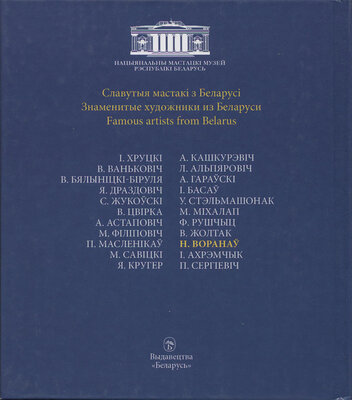Натан Воранаў
Выдавец: Беларусь
Памер: 99с.
Мінск 2016
Perhaps, this biography fact defined in many ways the features of the further work of N. Voranau. The artist who was temporarily left blind dreamt in total darkness about... colour! The human mind is set so that only deprived of something really
1 Бойка, У. A. Беларуская палітра дваццатага стагоддзя / У А. Бойка. — Мінск: Вышэйшая школа, 1976. — С. 98.
important in life we start to truly value it. Bedridden in a hospital in Leningrad Natan Maiseevich recollected how he had painted a bouquet of lilacs in a simple vase at his parents’ house on vacations in 1941. He clearly remembered how the colour scheme of that simple still-life had been changing depending on light. As soon as someone had opened the door, light had laid on objects absolutely differently and the colour scheme had changed from cold to golden beige... He also recollected entry exams to Vitsebsk Art College, when “strict and picky” E A. Fogt had tested colour sense of applicants with a handmade album, and its pages had reminded of a fanciful rainbow, according to the recollections of the artist. The artist would later create a great number of wonderful paintings varying in theme and composition. These paintings would become classical for the national art. However, being once deep in the world of total darkness and returning miraculously out of it, he would praise beauty of the material world illuminated by the variety of colour in its entirety all his life. Colour would take the principal place in his creative work for good.
In the years of war, Natan Voranau made graphic sketches of his fellow soldiers and of the places where he fought. But all the same, he dreamt about full-blooded, multicoloured, substantial painting... Soon after the long awaited Great Victory the artist managed to get paints and a canvas in the hospital. He would tell his relatives: “... I paint a portrait... I paint in oil for the first time since the bouquet of lilacs in Magileu in 1941...”2.
Already in 1946, N. Voranau was demobilized from the Soviet Army. For Merit for the Fatherland he was awarded the Order of the Red Star (May, 1944), Order of the Patriotic War II degree (February, 1945), the medal “For the Victory over Germany in the Great Patriotic War of 1941 —1945” (1945) and also had a number of government awards. Having fulfilled his civic duty, Natan Maiseevich fully immersed into the so much loved and desired world of art.
In 1948, Natan Voranau successfully graduated from I. E. Repin Institute of Painting, Sculpture and Architecture. His graduation work was a multi-figured composition Kovpak’s Raid. His teacher was legendary A. Osmerkin, who gave a good start to the young artist. At his time, Alexnander Alexandrovich was an active participant of exhibitions held by the famous association “Jack of Diamond”. His creative work
2 Бойка, У. A. Беларуская палітра дваццатага стагоддзя / У А. Бойка. — Мінск: Вышэйшая школа, 1976. — С. 100.
was greatly influenced by French Fauvism and Cubism, and artistic heritage of Paul Cezanne. Over time, Natan Maiseevich largely adopted the pedagogical skills of A. Osmerkin and his love to the avant-garde of the early twentieth century.
Arriving in Minsk in the late 1940s, N. Voranau confidently announced himself as a highly professional artist and soon earned audience recognition and respect of colleagues by participation in numerous Republican and All-Union exhibitions.
From 1966 and until his last days, N. Voranau taught at the Department of Drawing and Painting of the Belarusian State Theatre and Art Institute (now, the Belarusian State Academy of Arts). Students called him tenderly “Natasha” among themselves. Many of them would become the artists, whose creative work would take a rightful place in the national art (U. Toustsik, G. Baranau, I. Grinberg, A. Sukhan and others). According to grandson Pavel Kandrusevich, among his fellow professors Natan Maiseevich formed particularly warm relations with I. Akhremchyk and M. Dantsyg.
Already in N. Voranau’s graduation work Kovpak’s Raid depicting historical events of the last war, there is felt a confident hand of the master. The painting was shown at the All-Union Exhibition in Moscow dedicated to the 30th anniversary of the Komsomol and it was awarded the Third Degree Prize. Professional critics admitted the work by Natan Maiseevich to be a success of the young artist. The painting was many times reprinted on first pages and it was discussed in the press. For example, the following words could be read: “General attention was attracted also by the artist N. Voranau’s painting Kovpaks Raid, which illustrates massive national partisan movement...”3. However, criticism was not avoided. The same author commented: “...Speaking about Belarusian artists’ success in creating images of the best people of the republic, we cannot omit a significant drawback characteristic of a nuber of paintings. This drawback is in the incompleteness of works... In the paintings of Voranau and Tsvirka (The Unsubdued, 1947. — author’s note), figures at the middle ground are devoid of clear forms and defined contours. Certainly, it reduces the emotional level of the painting, deprives it of necessary power and force. It feels like a relic of formalism”4. Such
3 Меликадзе, E. Выставка белорусских художников I E. Меликадзе II Советское искусство. — 1949. -№7(1147). — С. 1.
Mbit.-S. 1.
a reproach on the part of official criticism had a real ground. Suffice to remember that N. Voranaus teacher A. Osmerkin was accused of formalism and propaganda of Western trends at that time. Nevertheless, it was no hindrance for a young graduate of the famous Leningrad university.
Several factors influenced the formation of Natan Voranaus artistic language and his credo. While analyzing the biography of the artist, it becomes evident that he was a man of his time. Natan Maiseevich always held an active social position: he was repeatedly elected member of the board of the BSSR Union of Artists, from 1963 to 1965 he served as Chairman of the Union and headed the primary party organisation. He was true to the ideals of his time and stuck in his creative work to principal dogmas of social realism — the only then permissible style in the official art. For three decades of his creative work the artist painted a great number of paintings on the historical and revolutionary theme, on the war theme, he painted portraits of his contemporaries, industrial and lyrical landscapes, still-lives. At the same time, the narrative painting remained a priority to the master. However, the work of Natan Maiseevich was beyond social realism. While saving the ideological basis of the official art, the pictorial and figurative aspects of his paintings are based on a creative reinterpretation of the heritage of Impressionism, Post-Impressionism and Fauvism. This combination of different artistic traditions with the undoubted colorist talent makes the artist’s work particularly attractive also to the modern audience.
The earliest work by N. Voranau in the collection of the National Art Museum of the Republic of Belarus is the canvas In the Shadow made in 1939 during the studies in Leningrad. The artist’s ability to create subtle colour balance of smoky pink, silver and green tones is clearly seen in this study painted from life. An effort to generalize to the utmost the image of a model and a slightly relative and planar manner of painting help to trace the influence of Post-Impressionism and artistic principles of the association “Jack of Diamonds”. Besides, the artist tries to the full to “fit” the figure of the model into the environment in the most natural way. The woman’s mood of dreamy contemplation is in tune with nature. Later, he would often use this principle in portrait painting by placing models into the atmosphere corresponding to the general plan of the work.
Other master’s canvases from the museum collection belong to the mature period of the career, when he already lived in Minsk. It is characteristic that once having chosen the way in art and decided on the themes the artist always remained
true to himself. It could only be mentioned that his later works are notable of the harmonious strengthening of the expressive manner and the use of more contrasting colours.
N. Voranau painted numerous works on the historical and revolutionary theme in the best traditions of the Leningrad academic school. Their content corresponds to the ideological lines in social realism. In such paintings as By Order of the Lenin Central Committee of the RCP (b). Minsk, 1919 (1952—1954), Morning in October. Minsk, 1917 (1955—1957), Belorussia. For Soviet Power (1966—1967), the artist turns to the events of the revolutionary past of Belarus. For each canvas, he finds interesting compositions and colour schemes. Preparatory studies painted from nature contributed to the convincing incarnation of a vision in those multi-figured works. Some of the studies are kept in the museum collection.
Perhaps, one of the most recognizable canvases by Natan Voranau for the public is Morning in October. Minsk, 1917. The painting depicts a Red Army unit guarding the order on one of the central streets in Minsk. N. Voranau wrote: It was my
long-held dream to show the Great October days in Belarus, and I tried to embody this dream in the painting... I wanted to show people of the revolutionary days full of ardent desire to defend the power of the Soviets. People with many trials of the war years ahead, defenders of the young Soviet Republic from external and internal enemies”5. Regardless the chosen theme, there is no pathetic element in the work. The composition is built in such a way that viewers seem to be present in the canvas space. After a rainy autumn night the unit sits around a fire near the Lower Market (now, Vos’maga Skavika Square). The dying fire glow reflects in puddles and lays on the faces and the clothes of the Red Army soldiers. A cityscape covered in the autumn mist carries a significant meaning in the painting. The colour scheme is built on the fine balance of silver lilac and blue colours.
 КНІГІ ОНЛАЙН
КНІГІ ОНЛАЙН


